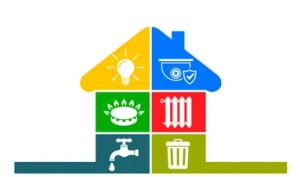[vc_row][vc_column][vc_column_text]
Let’s Talk Utilities, part 2: Water

In the last piece, we talked about several tricks and tips (but by no means all of them – there are dozens more) to lower your power consumption and, with it, your monthly power bill. Yet power isn’t the only utility where you might be paying much more than you need to. Although we tend to be more careful with water than with power, there are plenty of ways in which we’re wasting it without noticing.
As with the previous article, the following is a list of some things you can do to minimize your water-related expenses, leading to smaller bills and therefore more money available for you. Some of these will require an investment, and some won’t, but those that do will soon enough pay for themselves with the money you’ll save.
The basic one: Keep an eye out for leaks!
Water leaks are a part of living pretty much anywhere. Over time, and thanks to regular use, faucets wear and stop sealing water properly, leading to these little annoyances.
But you already knew that water leaking from faucets leads to higher bills, that’s nothing new. However, there’s a side of leaks you might have not thought about – or even preferred not to think about, due to how annoying these can be: Leaking pipes. Specifically, leaky pipes inside your house or apartment’s walls.
A broken or leaky pipe is extremely annoying, since fixing it often requires tearing down part of a wall, then rebuilding, which means it’s a slow, expensive process. But don’t skimp into these – while you’ll hardly save enough from a somewhat leaky pipe to make up for the repair costs, in the long term said leaks can lead to structural damage that will only make repairs even more expensive.
A silver lining, however – if you’re living in a rental, it’s the landlord’s responsibility to keep the pipes leak-free and pay for any repairs needed… but on the downside, less than nice landlords can use such repairs as excuses to raise your rent.
Efficiency is key
And by this I don’t mean having faucets open as little as possible, although that also does help.
Not all water faucets and showerheads are made the same. Particularly, older ones tend to be less efficient – and yes, I’m aware it doesn’t seem to make sense at first.
Let’s explain it. A faucet is essentially a little door that opens to let water through, then closes to keep it from running. Simple, right? What could be inefficient about this? The fact that there’s more to modern faucets than that, that is.
While older faucets and showerheads work in the basic way described above, modern ones go a step further by allowing lower amounts of water through and aerating the water output, delivering better water pressure and a more comfortable experience.
Wash only when needed
Look, nobody enjoys having a pile of clothes and a pile of dishes to wash. It’s just not something people like looking at every time they walk through their homes.
But there are advantages to not washing everything that needs washing, right away: Specifically, you can save water.
One great way to save money on your water bill is to limit your washing machine and dishwasher use exclusively to those times when you can fully load them. Strong as your desire for a tidy, orderly, perfect home might be, turning on these appliances whenever you get a chance sadly leads to huge amounts of wasted water.
Oh, and don’t even think about washing stuff by hand to circumvent this. If anything, your clothes and dishwashers make sure whatever water is used is indeed used efficiently. Washing a single item by hand is sure better than using your appliances for it, but washing a whole load of laundry or dishes by hand leads to much higher water waste than using the appliances.
Install low-flow toilets
Toilets are well-known water hogs. Every time anyone uses them, the full tank is emptied, leading to several liters of water lost.
Thankfully, low-flow toilets exist that allow you to use both low-water and full flushes depending on your needs – cutting toilet-related water expenses to less than half.
Even if you can’t afford a new toilet (and many of us can’t,) there are ways of minimizing your water expenditure for free. Specifically, you can fill an empty plastic bottle (a coke bottle will do) with 30% sand and the rest with water. Put that bottle in your toilet’s water tank where it won’t interfere with the flushing system, and done – now every flush will use less water.
Reuse rain water
Rain water is free water we often forget about.
While drinking rain water is definitely not advised, there are other tasks, such as watering plants or washing the floor/walls/clothes where the purity of water isn’t too important. For these, you can use rain water.
If you have a lawn, just keep a barrel or some container outside to gather water when it rains, then reuse as needed. This trick won’t erase your dependency to the local aqueduct, and it won’t work great in places under heavy drought (looking at you, California,) but it will certainly help.
[/vc_column_text][/vc_column][/vc_row][vc_row el_id=”Subscribe Section” css=”.vc_custom_1599253353022{margin-bottom: -10px !important;}”][vc_column][gem_fullwidth background_style=”cover” container=”1″ background_image=”39″ padding_top=”158″ padding_bottom=”100″][vc_column_text]
Start Your Journey
[/vc_column_text][gem_divider margin_top=”71″][vc_row_inner][vc_column_inner width=”1/6″][/vc_column_inner][vc_column_inner width=”2/3″][vc_column_text]
[/vc_column_text][/vc_column_inner][vc_column_inner width=”1/6″][/vc_column_inner][/vc_row_inner][vc_row_inner][vc_column_inner width=”1/6″][/vc_column_inner][vc_column_inner width=”1/6″][/vc_column_inner][/vc_row_inner][gem_divider margin_top=”56″][/gem_fullwidth][/vc_column][/vc_row]

Recent Comments